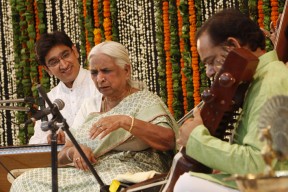There was a time not so long ago when the royal courts of Lucknow shimmered to the lilting melodies of thumri. Around 1847, the Nawab of Awadh, Wajid Ali Shah and his court singer Sadiq Ali Khan are credited with developing thumri into a popular style to which the courtesans danced. It is to revive this long romance with thumri that Sahitya Kala Parishad is presenting a three-day thumri festival in the capital starting next Friday.
Thumri, it is said, was born among the undulating hills of North West India as a form of music associated with Lord Krishna’s raas leela. While initially its compositions focused on Radha’s love for the young Govinda, it soon spawned other forms in its genre namely dadra, chaiti, hori, kajari, saawan and jhoola.
Over the past decades in Indian history, the generic musical style of thumri gained immense popularity among a varied audience that enjoyed its odes to nature and love. Its rhythm resonated even with the common man and North India’s most popular classical dance form of kathak became its ardent companion. However, contrary to popular belief, patronage of 19th century Indian royalty of Jodhpur, Kishangarh and the like was not the birthplace of thumri. Instead, historians believe that its songs of love for nature and the divine were first composed during the Gupta Period, around 550 CE.
In more recent times, unfortunately, thumri has lost its disciples to what are deemed to be higher classical forms like khayaal, dhrupad or taraana. Serious musicians have begun to see thumri as the ‘pop’ form of Hindustani classical music. As a result, new talent is losing interest in it thus preventing its growth. For those who grew up listening to the persuasive voices of Gauhar Jan, Begum Akhtar, Shobha Gurtu and Noor Jehan, this break from the past is indeed a bitter pill to swallow.
Says Sindhu Mishra, Deputy Secretary, Sahitya Kala Parishad: “Sahitya Kala Parishad has now taken an initiative to bring back the golden era of thumri. The Thumri Festival has been planned as a regular event that will promote new and established artists. Hopefully, with consistent exposure and dedicated endorsement, the music that once moved royalty and masses alike, will once again reign supreme.”
Speaking of artists, one cannot possibly talk about thumri without mentioning the reigning queen of this genre Girija Devi. Slated to perform on the final day of the festival, the Padmabhushan awardee belongs to the Benaras gharana and has been the leading force behind reviving thumri. Some people may be aware that she acted in the film Yaad Rahe in the B&W era when she was all of nine. As a singer, Girija Devi made her singing debut in 1949 on All India Radio, Allahabad, much against the wishes of her family. Talent, however, can never be suppressed for long and after her first public concert in Bihar in 1951, her voice became the one thumri aficionados grew listening to. In her 60 years as a performing artiste, there are few places left in the world where her voice has not been heard.
The best way to describe her talent is to listen to her own thoughts on thumri, “Khayal is like a ploughed field sown over with a crop of wheat or paddy. The harvest will yield only rice or wheat as it has a set pattern of growth and works much like a machine. It cannot produce another crop at harvest time. But thumri is like a garden of many flowers. Each one of them is a different coloured emotion stirring the human heart. The singer plucks these flowers of different hues and scents and makes a posy, woven of different ragas.”
There can be no doubt that the other five singers in the festival, each one an accomplished artist of this genre, will be proud to have shared the same stage with Girija Devi during this festival.
Thumri Festival will be held at Kamani Auditorium, Copernicus Marg, New Delhi, from Aug 26-28, 2011, 6.30 p.m. daily. Entry is free.
Programme schedule: Suranjana Bose & Shubra Guha (Aug 26), Anjana Nath & Purnima Choudhury (Aug 27), Kakali Mukherjee & Girija Devi (Aug 28)
Poonam Goel is a freelance journalist and has covered the arts for over 15 years. She contributes on visual arts for various newspapers, magazines and online media. More about her on Story Wallahs. Write to her @ poonamgoel2410@gmail.com







I am reminded of Begum Akhtar’s thumris “Zara dheere se bolo koi sun lega..” and Laxmi’s “Aaye nahi ghanshayam…” lovely ones. Wish thumris revive.I dont know if I can share this link on this website. Here it is though for those who want the taste of Thumri… http://www.youtube.com/watch?v=5BuHGxgtuRg